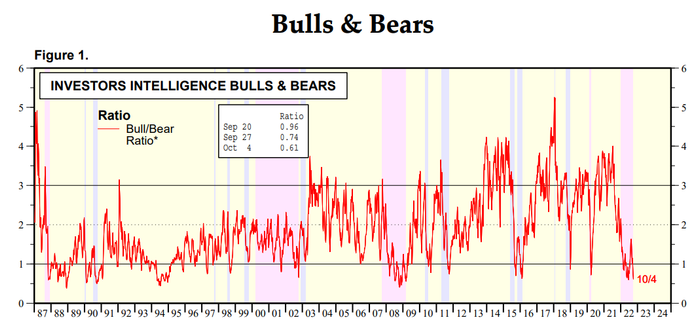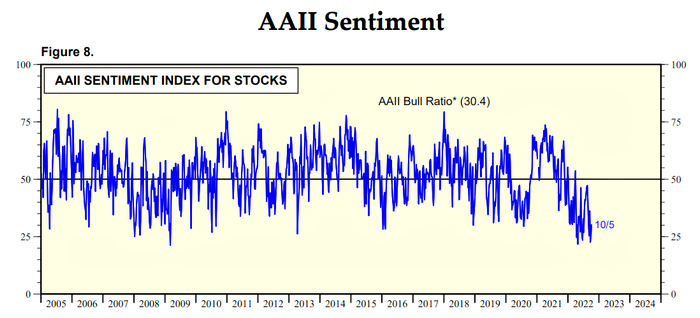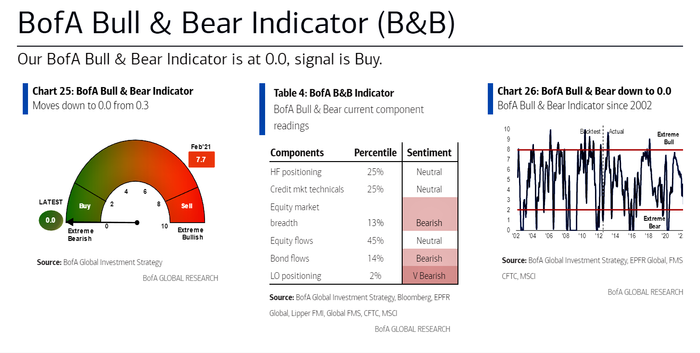If you are positive on the direction of the stock market and feeling lonely about it, that’s actually a good sign.
Historically, whenever most investors are extremely negative, the market is a buy. I’m talking about contrarian thinking, which tells us it generally pays to do the opposite of the crowd. The market adages sum it up: “When everyone’s crying, you better be buying.” “Buying right never feels good.” “Buy when there’s blood in the streets.”
But how can you really know when “everyone’s crying”? You turn to the sentiment gauges, which measure the desperation — and tears — quantitatively. Here’s a roundup of five of sentiment gauges that point to negative extremes, and an anecdotal one for good measure.
In the “meal for a lifetime” spirit, I demystify these indicators and explain simple ways to interpret them, so that you can consult them for the rest of your investing life. This won’t be the last bear market you’ll live through.
1. Investors Intelligence Bull/Bear Ratio
If you follow just one sentiment indicator, make it this one. This gauge is based on a survey of over a hundred market newsletter writers. Historically, when the ratio of bulls to bears is less than one, that’s a negative sentiment extreme, which tells us the market is a buy. The chart below, from Yardeni Research, shows the historical perspective. The reading on Oct. 4 stood at 0.61, an extreme low that demonstrates extreme negative sentiment. This is a bullish signal in the contrarian sense.

2. American Association of Individual Investors (AAII) sentiment survey
This gauge is based on a weekly AAII poll of its members, who are individual investors. Retail investors can be notorious crowd followers, so they offer an effective sentiment read.
You can see by this summary, below, that the data bounce around quite a bit. When this happens with data, analysts turn to rolling averages that smooth out the variance by incorporating several consecutive data points. Strategists at RBC Capital Markets suggest the following trick with AAII data. When the percentage bulls minus percentage of bears falls below -10 percentage points on a four-week average basis, it is a strong buy signal. The rolling four-week average spread is now -33.7, way beyond the -10 cutoff.
Also note that the last two bearish reads in September were nearly 61%. Before these reads, over the past 35 years the percentage of bears surpassed 60% just four times. One-year stock returns after those four events were +22.4%, +31.5%, +7.4%, +56.9%, notes Jason Goepfert at SentimenTrader.

A simpler way to use this measure is to consider the ratio of bulls to the number of bulls plus bears. As the chart, below, from Yardeni indicates, reads of 35 or below are very rare, which tells us they are buyable extremes. The reading in early October was 30.4.

3. The Bank of America Bull & Bear Indicator
Bank of America tracks a bull & bear indicator for clients. It measures things like hedge fund positioning, stock market breadth, fund flows into stocks and bonds, and the positioning of long-only funds. This one hits a negative extreme when it is at zero. It was there in early October. Investor sentiment is as bad as it was in the Great Financial Crisis and the early days of the pandemic — both of which were followed by very nice stock market gains.

4. Fund manager cash positions
Bank of America conducts regular surveys of fund managers to gauge their sentiment. One way to measure their mood is to look at how much cash they hold. Moving to cash is a cautionary stance that suggests a money manager thinks stocks will fall. Historically, when cash positions in this survey are at 5% or higher, the stock market is a buy. Cash positions were recently at 6.1%, a solid buy signal.
5. Valuation extremes
Valuations measure sentiment, because investors sell stocks when they are bearish.
The price-to- earnings ratio of the Russell 2000
RUT,
a small-cap index, recently fell to 11. This looks like an extreme because that is the lowest it has been since 1990, and it is 30% below its long-term average since 1985, notes Bank of America.
Mid-cap stocks look cheap too, but not as cheap as small-caps, compared to their history. And large-cap stocks remain the most expensive. The forward P/E of the Russell 1000
RUI,
a large-cap index, recently fell to 15.5, which is roughly in line with its long-term average.
But note the difference between small-caps and large-caps. The relative forward P/E of the Russell 2000 (small-caps) vs. the Russell 1000 (large-caps) is at 0.71, well below its historic average of 1.01. It is at the lowest levels since the tech bubble. This chart shows you the historical perspectives.

These valuation reads are a good buy signal. Judging by historical trends, these valuation discounts imply a 13% annualized return over the next decade for the Russell 2000 and a 10% for the Russell 1000. The message here is that it pays to favor despised small-cap stocks now because they are much cheaper compared to their history. A simple way to do this is to buy a small-cap exchange traded fund (ETF) like the iShares Russell 2000 Growth ETF
IWO,
An anecdotal measure
“If there is a recession, it will be the most widely anticipated recession ever, which means it probably won’t happen,” Ed Yardeni, at Yardeni Research, told clients in a meeting Monday.
He’s referring to the broad concerns about the possibility of a Fed-induced recession you now read about every day in the financial press. This widespread hand-wringing is an anecdotal sentiment read. Anecdotal reads are based on informal observations, not hard data, but they can still be quite effective.
Look for anecdotal indicators in your personal life. For example, you may have a friend or family member who consistently asks for stock ideas at market tops, or tells you they have sold everything and gone to cash at market bottoms. If not, be on the lookout for this person in your life. Even if you tell them they are a good contrarian sentiment gauge, it won’t dull the signal because psychology and habits tend to be hardwired in our brains.
While we are on the topic, you may be your own best sentiment measure. Track how you feel and behave at extremes, so you can spot those signals again in the future.
As for the probability of recession, note that employment remains strong, consumer spending remains robust (10% year-over-year growth in September, according to Bank of America client observations), the Atlanta Fed GDPNow estimate puts third-quarter growth at 3.9%, and credit spreads are not blowing out the way they typically do heading into a recession.
How I might be wrong
1. Sentiment indicators offer a good long-term perspective on when to buy stocks, but they do not provide pinpoint precision. During the Great Financial Crisis, the Investors Intelligence Bull Bear ratio was below one (which triggers a buy signal) for more than a year before the stock market got back into an uptrend. That’s an exception, though. Normally its trips below one last a matter of months or less.
2. Not all sentiment indicators are at negative extremes. The Chicago Board Options Exchange Volatility Index
VIX,
needs to go above 35 to flash a buyable negative sentiment extreme, in my view. It only hit 33.6 on Tuesday. That’s close, but some strategists including Bob Doll at Crossmark Global Investments like to see a move up to 40 to signal capitulation.
3. Wall Street “sell side” strategists at investment banks have not turned extremely negative yet, according to Bank of America’s tracking of this measure. The banks says this gauge is still neutral, but closer to buy than sell. To me, though, it may be close enough. Historically, when their sell-side strategist indicator was at current levels or lower, subsequent 12-month returns were positive 96% of the time vs. a historical average of 82% of the time, and the median 12-month return was 21%.
That seems pretty close to a “buy” signal to me.
Michael Brush is a columnist for MarketWatch. At the time of publication, he had no positions in any securities mentioned in this column. Brush is editor of his stock newsletter, Brush Up on Stocks. Follow him on Twitter @mbrushstocks.
